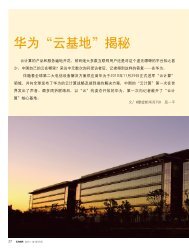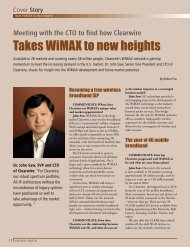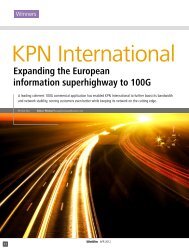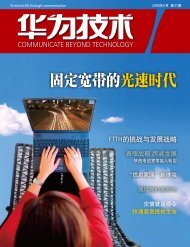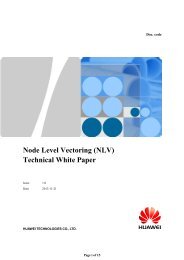EMOBILE: the mobile broadband revolutionist - Huawei
EMOBILE: the mobile broadband revolutionist - Huawei
EMOBILE: the mobile broadband revolutionist - Huawei
Create successful ePaper yourself
Turn your PDF publications into a flip-book with our unique Google optimized e-Paper software.
As <strong>the</strong> largest and leading <strong>mobile</strong><br />
operator of Thailand–<strong>the</strong> “Land of<br />
Smiles”, Advanced Info Service (AIS)<br />
has realized a ubiquitous and rich<br />
information network through its brands such as<br />
GSM ADVANCE, ONE-2-CALL!, GSM1800,<br />
and MPAY STATION, which cater for <strong>the</strong> 26<br />
million local subscribers and tourists.<br />
The dominant influence of AIS has ensured<br />
critical involvement in <strong>the</strong> development of<br />
Thailand’s domestic telecom industry which, in<br />
turn, has profoundly and positively impacted <strong>the</strong><br />
Thai economy and its 64 million inhabitants.<br />
Elevating 2G services<br />
Thailand has been noted for its outstanding<br />
scenery and remarkably friendly locals. As one<br />
of <strong>the</strong> world’s most popular tourist destinations,<br />
Thailand boasts an internationally famous cuisine<br />
and a wealth of attractions. In <strong>the</strong> first half of 2008,<br />
Thailand hosted around 5.62 million tourists;<br />
approximately 70% of <strong>the</strong> country’s industries are<br />
related to tourism, and over 7% of its GDP directly<br />
results from its visitors.<br />
Fulfilling <strong>the</strong> communication requirements of<br />
this significant tourist economy is vital for AIS to<br />
realize full value potential. However, prior to 2008,<br />
this objective was hampered by networks in tourist<br />
heavy-traffic areas such as Bangkok. At that time,<br />
<strong>the</strong> AIS network for Thailand’s capital city was based<br />
on European-sourced equipment. Each cabinet<br />
occupied around 1m 2 , weighed up to 600kg, and<br />
only supported <strong>the</strong> S4/4/4 configuration.<br />
Toward <strong>the</strong> end of 2007, AIS was confronted<br />
with untenable circumstances and apparently<br />
impossible problems. Service capacity expansion<br />
would require heavy investment in additional<br />
equipment rooms and related engineering. The<br />
resulting CAPEX coupled with a slow market<br />
response would have been disastrous for <strong>the</strong><br />
company’s development and revenue streams. This<br />
situation was exacerbated by <strong>the</strong> network’s low<br />
power output and reception sensitivity, both of<br />
which restricted uplink and downlink coverage and<br />
greatly degraded service quality. Additional BTSs<br />
were clearly indicated to remedy this situation, but<br />
again this would increase <strong>the</strong> company’s CAPEX<br />
and OPEX beyond acceptable limits.<br />
Back in 2007, <strong>the</strong> lag problems in Bangkok were<br />
not <strong>the</strong> only ones confronting AIS. The original<br />
GSM equipment covering <strong>the</strong> nor<strong>the</strong>ast and south<br />
of Thailand had been in use for over five years; <strong>the</strong><br />
original manufacturer was unable to provide fur<strong>the</strong>r<br />
technical support; <strong>the</strong> network framework could not<br />
support EDGE services, and future evolution based<br />
on <strong>the</strong> old equipment was out of <strong>the</strong> question. AIS<br />
could not accommodate <strong>the</strong> apparent upgrade costs<br />
but, in <strong>the</strong> midst of a boom in Thailand’s tourism, if<br />
<strong>the</strong>y did not upgrade <strong>the</strong>y would lose vital end user<br />
revenue to <strong>the</strong> advantages offered by <strong>the</strong> improved<br />
quality of competing vendors networks. AIS had no<br />
choice but to refine its original network, particularly<br />
in peak traffic areas, and extend coverage to boost<br />
user QoE. The question was, how to do this costeffectively<br />
and time-efficiently while hopefully<br />
gaining long-term advantages at <strong>the</strong> same time?<br />
As 2007 drew to a close, AIS embarked on a<br />
cooperative venture with <strong>Huawei</strong>. The two companies<br />
carefully analyzed Thailand’s key GSM markets<br />
with <strong>the</strong> goal of invigorating <strong>the</strong> AIS network and<br />
accommodating immediate and future expansion.<br />
In early 2008, AIS embarked on <strong>Huawei</strong>’s solution<br />
for GSM equipment replacement in Bangkok, and<br />
across <strong>the</strong> major tourist areas of north, nor<strong>the</strong>ast,<br />
and south Thailand. In three short months, and in<br />
good time to realize benefit from <strong>the</strong> heavy local<br />
traffic increase and tourist surge occurring around<br />
April’s Thai Water Festival, a remarkable total of over<br />
10,000 carriers were replaced.<br />
In key areas such as Bangkok, AIS opted for<br />
<strong>Huawei</strong>’s highly integrated indoor and outdoor<br />
macro base transceiver stations (BTSs). Occupying<br />
less than 0.5m 2 , <strong>the</strong> <strong>Huawei</strong> BTS supports up to 18<br />
or 36 carriers, and simplifies constructing S8/8/8<br />
sites and those of a higher configuration. During<br />
seasonal traffic peaks, using software to upgrade RF<br />
modules in phases from one carrier to six carriers,<br />
AIS can now configure <strong>the</strong> <strong>Huawei</strong> BTSs to meet<br />
demand. The <strong>Huawei</strong> solution eliminates <strong>the</strong> need<br />
for on-site engineering and antenna adjustments,<br />
significantly reducing AIS’s O&M costs and<br />
accelerating <strong>the</strong>ir ability to more quickly respond<br />
to market requirements.<br />
In remote scenic spots and along <strong>the</strong> highways<br />
linking Thailand’s tourist cities, AIS adopted<br />
<strong>Huawei</strong>’s small, six-carrier GSM BTSs. These BTSs<br />
meet requirements for capacity and coverage without<br />
<strong>the</strong> need for deploying additional equipment and<br />
equipment rooms, but can still be located outside<br />
and withstand <strong>the</strong> humid and rainy local climate.<br />
Along <strong>the</strong> highway to Chiang Mai, for example, AIS<br />
was able to discretely mount <strong>the</strong> compact <strong>Huawei</strong><br />
FEB 2009 / Win-Win<br />
26



